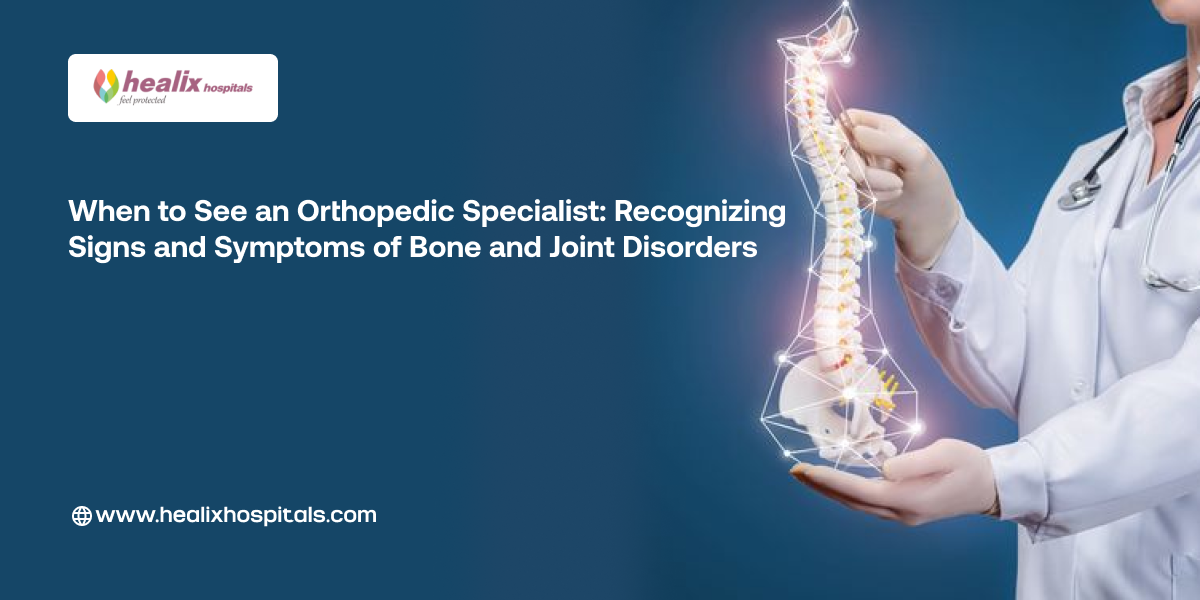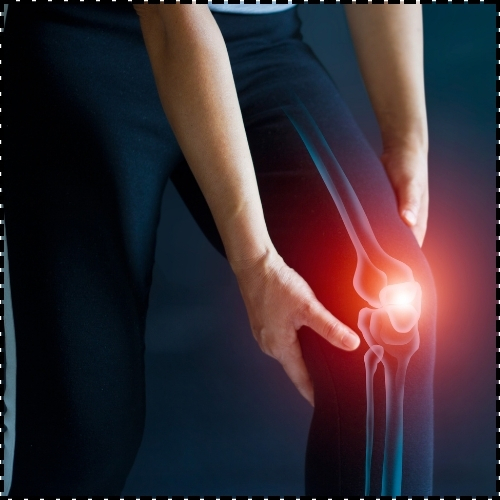When to See an Orthopedic Specialist: Recognizing Signs and Symptoms of Bone and Joint Disorders


Understanding when to seek medical help for bone and joint issues is crucial for maintaining musculoskeletal health. Knowing the right time to consult an orthopedic specialist can make a significant difference in managing bone and joint disorders effectively. At Healix Hospitals, we are committed to providing expert care for these conditions. This blog will guide you through the signs and symptoms that indicate it may be time to see an orthopedic specialist and how Healix Hospitals can assist you.
When to See an Orthopedic Specialist: Key Indicators
When to see an orthopedic specialist often depends on the severity and persistence of symptoms related to bone and joint disorders. Here are key indicators that suggest it might be time to consult an orthopedic expert:
- Persistent Joint Pain: If you experience joint pain that doesn’t improve with rest, medication, or home remedies, it may be time to seek professional help. Persistent pain can be a sign of underlying issues such as arthritis or joint damage.
- Limited Range of Motion: Difficulty in moving a joint fully or experiencing stiffness that impairs daily activities can be a sign of musculoskeletal disorders. Consulting an orthopedic specialist can help in diagnosing and treating the underlying cause.
- Swelling and Inflammation: Swelling, redness, and warmth around a joint often indicate inflammation or injury. If these symptoms persist despite home treatment, orthopedic care for joint disorders may be necessary.
- Acute Injury: In the case of a sudden injury, such as a fracture or severe sprain, immediate consultation with an orthopedist is crucial. Proper diagnosis and treatment are essential to ensure proper healing and prevent long-term issues.
- Chronic Back Pain: Persistent back pain that doesn’t improve with conservative treatments might indicate serious issues like herniated discs or spinal stenosis. Seeing an orthopedic specialist for joint pain diagnosis is essential in such cases.
- Difficulty Walking: If you have trouble walking or experience pain while walking, it could be due to bone and joint disorders. An orthopedic evaluation can determine the cause and recommend appropriate treatment.
- Numbness or Tingling: Numbness or tingling in your extremities can be a sign of nerve involvement or other serious conditions. Recognizing bone problems early can prevent further complications.

Signs of Orthopedic Issues
Recognizing the signs of orthopedic issues can help in deciding when to see an orthopedist. Key signs include:
- Severe or Unmanageable Pain: Pain that disrupts your daily life or persists despite treatment.
- Instability or Weakness: Feeling unstable or weak in a joint or limb.
- Visible Deformities: Any noticeable deformity or misalignment in the bones or joints.
- Persistent Stiffness: Ongoing stiffness that affects your ability to perform routine tasks.
If you notice these symptoms, it’s crucial to consult with an orthopedic specialist to prevent further damage and improve your quality of life.
Symptoms of Joint Problems and Their Implications
Understanding the symptoms of joint problems is essential for timely intervention. Common joint disorder symptoms include:
- Pain: Persistent or severe pain in a joint or bone that doesn’t subside with rest or medication.
- Swelling: Swelling in or around a joint, often accompanied by warmth or redness.
- Stiffness: Difficulty moving a joint, particularly in the morning or after prolonged periods of inactivity.
- Deformity: Any visible changes in the shape or alignment of a joint or bone.
- Reduced Functionality: A decrease in the ability to perform daily activities due to joint pain or stiffness.
Addressing these symptoms early can help in the effective management and treatment of musculoskeletal disorders.

Diagnosing Bone and Joint Disorders
When you seek orthopedic treatment at Healix Hospitals, our approach involves a comprehensive evaluation to diagnose your condition accurately. The process includes:
- Detailed Medical History: Reviewing your medical history to understand past injuries, family history of bone disorders, and overall health.
- Physical Examination: Assessing your joint function, range of motion, and physical symptoms.
- Imaging Tests: Utilizing X-rays, MRIs, or CT scans to get detailed images of bones and joints for accurate diagnosis.
- Diagnostic Injections: In some cases, diagnostic injections may be used to identify the source of pain.
Treatment Options at Healix Hospitals
Once a diagnosis is made, Healix Hospitals offers a range of treatment options for bone and joint disorders:
- Physical Therapy: Customized exercise programs to improve strength, flexibility, and joint function.
- Medications: Pain relievers, anti-inflammatory drugs, or disease-modifying medications based on your condition.
- Injections: Corticosteroid injections or hyaluronic acid injections to alleviate pain and inflammation.
- Surgical Interventions: Procedures such as arthroscopy, joint replacement, or realignment surgery for more severe cases.
- Lifestyle Modifications: Recommendations on activity modifications, weight management, and ergonomic adjustments to support joint health.
Recognizing Bone Problems and Seeking Timely Care
Recognizing bone problems early and seeking timely care can prevent complications and improve outcomes. If you experience any of the signs or symptoms mentioned, don’t hesitate to seek orthopedic treatment at Healix Hospitals.
Comments